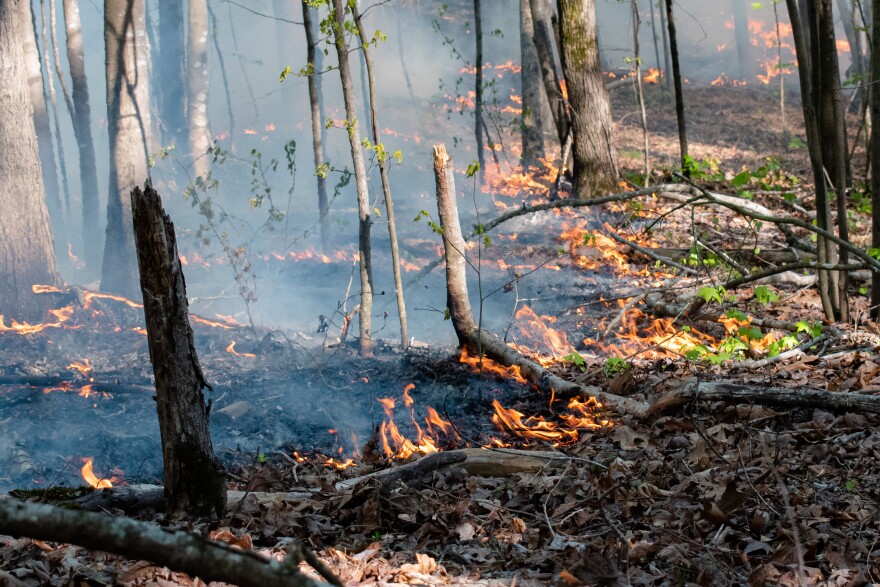In 2015, Jesse Wimberley founded the Sandhills Prescribed Burn Association to educate community members on controlled burns and put fire back on the land.
“My family's been burning for four generations, and we learned it 150 years ago from the Lumbee Tribe,” Wimberley said.
Last week, he co-organized a controlled burn with Pat Daystar Dial, owner of Turtle Mountain Farm near Mt. Gilead and a member of the Lumbee Tribe.
“My folks were burning 100 years ago,” Dial said. “My grandfather was born in 1890, and I know his folks were burning.”
Dial burned 12.5 acres near the front of her property.
Controlled burns are a land management technique that provide many benefits to the forest. Depending on the ecosystem, some seeds lie dormant underground until they experience fire. These burns also reduce the leaf litter and detritus that pile up, dry out and provide ready fuel for catastrophic wildfires. This becomes increasingly important as the climate continues to warm and droughts worsen. For example, fire weather days in North Carolina’s Northern Piedmont increased 13 days on average since 1973.
Courtney Steed, the Lumbee Tribe’s cultural burn coordinator, said it’s also about building community for both tribal and non-tribal members of the burn association.
“We see fire as medicine. It is medicine for the land, but it is also medicine for our people.
“We did our inaugural burn at the Cultural Center, and it aligned with the winter solstice so that we could incorporate the elder fires. We have always come together to celebrate that return of the light. So, fire is really at the center of it all,” Steed said.

The burn begins with a small test fire to gauge how the wind and dryness of the fuels will impact the intensity of the blaze. Steed grabs a drip torch, which looks like a paint bucket with a long spout on the end. A mixture of burning gas and diesel drips onto the ground like magma. Dial and her friend Robert Carter, an elder of the Lumbee Tribe, pinch some tobacco from a pouch slung around his neck.
“My brother and I, we just gifted some tobacco back to the land as a gesture of gratitude and thanksgiving for this,” Dial said.
Building 'black'
The burn begins. Step one, the burners must create a charred buffer zone on the northern edge where the wind is blowing.
“We’re building black,” said Wimberley. “Black is our friend because black can’t burn.”
When that black area regrows, it’ll create habitat for turkeys, pine snakes, gopher turtles and other species that favor recently burned forests.
The burners communicate up and down the fire line via radio. The watchers stand along the perimeter of the burn unit, looking for fires that creep too high along the trees or stray embers caught on the breeze.

On the eastern edge, Robert Carter works on the leaves under a fallen tree. According to Wimberley, there are two types of fuels: “one-hour fuels,” which are the leaves and straw, and “hundred and thousand-hour fuel” which includes stumps and logs. They don’t want to burn the latter, so Carter rakes away any surrounding the dead tree.
The burners work their way back and forth like text on a typewriter. On the western edge of the burn unit, smoke billows over Dial’s driveway in a blinding mist that burns when you inhale.
“Right now is the most difficult time of the burn. How are we watching that line with all that smoke in it? This is where it gets tough. You have to eat the smoke to guard your line.”

The climate solutions we forgot
Unmai Arokiasamy follows their spouse down the fire line. They pick up a tire that sits in the path of the creeping fire.
Controlled burns predate colonization in the United States. Federal intervention interrupted those practices — think Smokey the Bear — but now, Arokiasamy and others are rekindling that relationship with the land.
“Looking at this burn line [and] being with these people right now is a way to transcend time and space,” Arokiasamy said. “It doesn't matter if this is Native people here, if this is not native here. At the end of the day, we brought a community together to do something good for the land.”

The burn lasted over three hours. Near the front of the burn unit, Dial stood next to her ATV, spraying water from the tank in the back. She sprayed a stump that caught fire that she didn’t want to burn.
“It's always a blessing when the rain comes,” said Dial. “Last burn, we had it rain during the night. It's not going to happen today.”
Smoke lingers over the charred earth, curling around the scorched pine trunks. It won’t fully dissipate until the next rain.
Human relationships with the land are often one-sided, extracting minerals from the ground, fracking for natural gas or releasing our waste in waterways. With about seven prescribed burn associations across the state, controlled burns are a chance for people to give something back to the land.
“It's just refreshing,” Dial said. “It’s like sweeping the floor of the forest, cleaning it up. And it'll be interesting what pops up that hasn't had a chance to emerge.”




